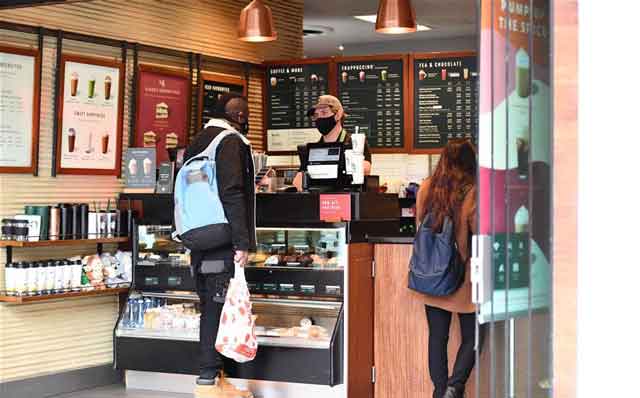
Sydney, Austria | XINHUA | The Australian State of Victoria has taken the next highly anticipated step towards “COVID normal” as it eases its way out of a long and difficult lockdown.
As of Monday, Victorians were given more freedom to travel and socialize after nearly three months of being largely confined to their homes — during which time the number of daily cases has plummeted from over 700 to less than five.
Despite its success in suppressing the virus, the lockdown has taken a toll on Victoria’s population and businesses which many expect will take years to recover from, fuelling criticisms of the Victorian government and prompting calls for an earlier easing of restrictions.
Following the changes, Australian Prime Minister Scott Morrison released a joint statement with other senior ministers welcoming the partial easing, but adding that the state should go further to relieve the burden on struggling businesses and individuals.
“Whilst the Premier’s announcement of the Victorian government’s decisions today enables some businesses to return to a limited COVIDSafe operation, many remain closed,” the statement said.
“The continued health, mental health and financial impacts of these restrictions will be profound on many Victorians.”
Senior Lecturer at the Monash University Business School in Melbourne, John Vaz told Xinhua that he too had issues with the way the lockdown had been handled in Victoria, primarily the lack of a clear and transparent plan.
“I believe the population is gradually getting impatient because of the lack of clarity around these things,” Vaz explained.
“Where are we going? What will COVID normal look like? Will I be able to have Christmas with my grandkids? Will I be able to see my family again? Will I even have a job? Will I be able to put that Christmas dinner on the table?”
Vaz called for the government to better explain its decisions regarding the suppression of the virus and to put a plan in place for the months and years ahead which can give businesses enough certainty and foresight to survive.
“This is really about how many more businesses are being damaged, and how many more can survive. They’ve been in a prolonged state now of having restrictions and so on and a lot of damage has been done,” he said.
However, though early estimates had the Victorian lockdown costing Australia’s economy between 10-12 billion Australian Dollars (7.08-8.5 billion U.S. dollars), some say the figure could have been far larger had the state taken a more flippant approach to suppressing the virus. Victoria Premier Daniel Andrews also defended the state government’s cautious approach.
“I know these changes can’t be absolutely everything everyone wants, but they are the steps we can safely take that will make life a little bit easier,” Andrews said.
While significant, the changes offered little relief for hospitality and retail businesses in capital city Melbourne, with owners told they will need to wait until next month to reopen.
On an individual level, however, they did offer more freedoms, including expanding a limit on the distance residents were allowed to travel from their homes from 5 km to 25 km.
Residents will also now be allowed to leave their homes for as long as they like, although will only be able to gather in groups of no more than 10 people from two separate households.
Infectious disease experts are among the main supporters of Victoria’s strict lockdowns, repeatedly emphasizing the potential for cases to spiral out of control without decisive action, and maintaining that Victoria’s reduction of cases was overwhelmingly positive and worth the immediate cost.
Biostatistician and epidemiologist at the University of South Australia, Professor Adrian Esterman told Xinhua that to get case numbers under control in Victoria, especially when compared with situations overseas, meant the government’s approach had worked extremely well.
As Andrews himself pointed out, at the beginning of the lockdown in early August, daily case numbers in Victoria were comparable with those in Britain, with 725 and 891 respectively.
However on Monday as Victoria recorded four new cases, Britain hit 16,982, with the situation there overwhelmingly local health services and economies alike.
Esterman also shifted the onus of Victoria’s prolonged lockdown away from the government and on to the public themselves, who despite overwhelmingly cooperating with restrictions also saw several individual actors placing the entire scheme in jeopardy.
“The tail hasn’t gone down as fast as everyone was hoping, not through any fault of the government’s really, but because individuals have been basically breaking the requirements and causing clusters,” Esterman said.
Esterman explained that the current strategy of the Victorian government was to relax only the restrictions which provided the greatest improvement in terms of quality of life in order to offer some relief, while at the same time having the least chance of increasing transmission.
“Their priority at the moment will be on people’s quality of life rather than the economy because people are going stir crazy, they’ve been locked down for so long now that it’s causing some major issues,” he said.
Last week a report said that the number of people reaching out to access mental health services in Victoria had skyrocketed, vastly surpassing figures for the rest of the country.
Esterman agreed that one of Andrews’ government’s main issues had been a failure to communicate effectively with the public the reason for the lockdown, and why it is imperative for them as individuals to follow the regulations.
Meanwhile calls continued for Victorian officials to formulate and illustrate a clear plan for dealing with the virus moving forward, keeping their economy open while avoiding another outbreak.
Vaz believes that Victoria can reopen businesses with minimal risk to public health by implementing clearly-defined frameworks for them to operate in, similar to other legislative frameworks that exist for businesses.
For instance he points to workplace safety requirements such as the need for construction workers to wear high visibility and protective clothing, as well as undergo government mandated training in safe practices.
In addition Vaz advocates testing, not just in the workplace but also randomly within the population to establish patterns of risk and stay on top of potential outbreaks.
Esterman agrees that testing is one of the main factors, which will keep Victoria from reverting to lockdown in the future.
“The key is always testing, contact tracing and quarantining,” he said, adding that he believed the difficult lessons learnt by Victoria over the past three months would help them deal with the challenges which lie ahead.
“I would be very surprised if they had any major explosions of cases now, I think they have got sufficient experience and procedures in place that they can clamp down.”
*********
XINHUA
 The Independent Uganda: You get the Truth we Pay the Price
The Independent Uganda: You get the Truth we Pay the Price


